Chapter 10
Buyers Who Buy Insights
Three senior vice presidents (SVPs) at a marketing services company had been coming to RAIN Group events for years. Several times they requested meetings at our office to discuss possibilities for how to grow their company. This firm was just higher than $100 million in revenue, but for the past five years or so, the top line had been relatively flat.
The company had a great value proposition, a solid industry position, and a series of advantages over the competition that could fuel its growth. It could fuel it, that is, if the company were willing to invest in its own sales and marketing engine to scale up.
The three SVPs were energetic and passionate about the growth possibilities. After our conversations, they convinced us growth was within reach. However, they didn’t seem to be able to get the internal buy in they needed to get an initiative underway.
We asked them, “What do you think it will take for the company to be ready to go from discussing this to jumping in with both feet and making it happen?”
They looked at each other for a bit, and then one said, “My guess is nothing is going to happen until the old man dies.”
They were completely serious.
It turns out years earlier the old man, what they mostly affectionately called the owner and chief executive officer (CEO) was hell-bent on growth—constantly scanning the market for innovation and very impatient with the status quo. In the past decade, however, he hadn’t done much at all.
The SVPs thought if they brought him concrete, defensible ideas for growth, he’d go for it. As it turned out, now, at the end of his career, he was satisfied with the way things were. Even if growth were possible, he was riding out his last few years collecting cash.
As we cover throughout this book, if you want to succeed with insight selling, there are things you as the seller must do. It takes two to tango, though. Your buyer has to be ready to dance. The fact is some buyers can be inspired to buy and some can’t; some buyers are good buyers for bold ideas and innovations and some aren’t.
To figure out which buyers are which, sellers need to be able to:
- Identify whether the buyers are in the right buying mode to buy anything at all (Figure 10.1).
- Identify the buyers’ personas—their buying styles and preferences—to get a sense of whether they are likely to be good buyers for new ideas and innovative offerings.
Two Buying Modes
- Q. How many psychologists does it take to change a lightbulb?
- A. One, but the lightbulb has to want to change.
To implement insight selling effectively, you must be able to identify decision makers who are not content with the status quo. When decision makers are, inertia will keep them from doing anything proactive. They are, essentially, the lightbulbs that don’t want to change.
There are two buying modes—problem solving and future seeking—where the lightbulb wants to change, and two nonbuying modes—satisfied and euphoric—where the lightbulb doesn’t want to change.
If sellers are going to drive demand, they must find decision makers in one of the two buying modes. If they don’t find such buyers, no matter how good of a case sellers may make, inertia will likely keep decision makers from doing something new that might benefit them but that they don’t have to buy.
When buyers are in one of the two buying modes, they’re scanning the market for ideas and insights for what to do—and what to buy—to improve their situation.
Problem Solving
When buyers are in problem-solving mode, they’re actively looking for ways to make improvements in areas that should be performing better (Figure 10.2). The problems could be with the business as a whole (e.g., revenue decline, profit decline, loss of market share, increased competition, and lack of innovation) or in specific areas (e.g., aging assets, process inefficiencies, and underperforming teams).
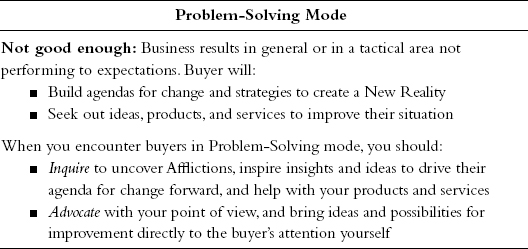
Figure 10.2 Problem-Solving Mode
Buyers in problem-solving mode often do not know exactly what they want to fix or how they want to fix things, but they are inclined to take action somewhere. And they’re looking to do it proactively. As they’re looking around for ways to solve their problems, they’re open to the overtures of sellers. You’ll recognize a buyer is in problem-solving mode when he or she takes a call or responds to an e-mail and says, “Normally I don’t take these calls. But you happened to reach out at just the right time as it turns out I’m looking to upgrade in this area.”
When sellers encounter this buying mind-set, they should first inquire to uncover afflictions and help solve problems with products and services and then advocate to show buyers new ideas and possibilities for how to improve.
Now, you might ask, “If something isn’t working optimally in a business, wouldn’t every decision maker be in problem-solving mode?” For example, if a leader knows his sales force is below average, wouldn’t he take action to fix it? Not necessarily. Given what we do, we know many leaders who recognize their sales forces are subpar, but they’re either satisfied with the status quo (like the old man) or just not willing or able to put in the effort to improve things.
Such prospects are not in problem-solving mode. Even if problems exist, they’re in the nonbuying mode we call satisfied. In this situation, although it’s not impossible, it would be a big challenge for a seller to convince a leader who thinks things are good enough to pursue improvements—even if things could be much better than they currently are.
Talented insight sellers might be able to make a sale to a satisfied buyer because of their perseverance, ability to apply the 3 levels of RAIN Selling, business acumen, and gravitas, but they probably wouldn’t bother trying because their sense of urgency, performance orientation, and money orientation would intervene. A little voice in their head would say, “You could win, but if you do it’ll take a lot more time and effort than if you found a buyer with an agenda for action. No Pyrrhic victories. Go find buyers who want to do something.”
Future Seeking
The second buying mode is future seeking (Figure 10.3).
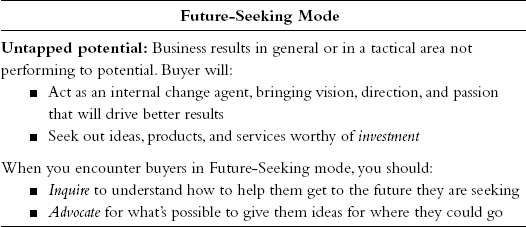
Figure 10.3 Future-Seeking Mode
When buyers are future seeking, they’re looking to grow their companies or improve their business or personal situations. In any case, they’re bent on driving the organization forward.
Following our previous example, perhaps they know their sales force is performing relatively well, yet if they see anything that can boost effectiveness, they’d be open to it. Relatively well isn’t good enough for them, anyway. A satisfied buyer might say, “Look, we’re doing better than average. This ain’t broke. Let’s not fix it.” Whereas a future-seeking buyer would say, “First of all, better than average is not something to aspire to. You want average, go work for someone else. We can be the best. Second of all, we could have 20 percent more revenue right now if we raised our game. Let’s make it happen. Who has ideas on how to get it done?”
Might as well be you.
With future-seeking buyers, even if nothing is broken per se, they’re constantly looking for ways to improve, and they’re willing to invest if the return is worthwhile. Future-seeking buyers are the entrepreneurs in their organizations. They’re looking to make things happen and make a difference. To do this, they need insight on what’s possible.
When you encounter future-seeking buyers, focus on their aspirations: Inquire to learn about their visions and agendas. Advocate to give them a sense of what they could achieve and provide ideas for how to turn their aspirations into reality.
Note that when we say to focus on aspirations, we don’t mean do that to the exclusion of afflictions. You might say to a buyer, “If it’s a few years from now and you get where want to go, what would that look like?” Most future-seeking buyers enjoy talking about their vision. You can then ask, “What do you believe are the biggest obstacles in the way of getting there?” Same goes for buyers in problem-solving mode. You ask, “What’s not working for you right now that you want to change?” A frustrated problem-solving buyer will typically start sharing—or venting. You can then ask, “If everything wasn’t simply working better but was turning out as well as you think is even possible, what would that look like?” It’s mostly a matter of point of view: Aspirations will resonate best with future seekers and thus should take the lead and vice versa for afflictions and problem solvers.
There’s one other nonbuying mode: euphoric. Even when a seller might see how things can be better, if prospects think things are great or think they can do everything themselves (“We don’t need external help!”), then there’s little a seller can do to convince them to change their course. The decision maker is probably too busy keeping up with growth and counting his or her profits as they roll in. Such prospects rarely want to rock the boat when things are going, at least in their minds, so well. Sellers should be particularly aware of the euphoric mind-set because buyers who are euphoric have often had success come easily. Euphoric decision makers are frequently unwilling to invest, and although they may be flush with cash, they can be price sensitive.
In any case, sellers must find the buyers who are in problem-solving and future-seeking modes and avoid nonbuyers who are either satisfied or euphoric.
Six Buyer Personas and Insight Selling
Assume for a moment you find buyers who are in problem-solving or future-seeking mode. They want to do something, but will they do something bold? Something new?
The fact is some buyers are better for new and big ideas than others. Then there are those buyers who might be inclined to buy big ideas (they want the mountain) but can get in their own way and scuttle their own grand plans (they end up with the molehill).
Fortunately, with a little study of and practice with the six buyer personas we outline in this chapter, insight sellers can learn to identify who’s who, focus their attention on the buyers most likely to buy, and adjust their selling approach to the way each buyer persona prefers to buy.
RAIN Group developed the six buyer personas to help salespeople recognize different buying styles and preferences and learn the skills to facilitate sales success with each. Descriptions of the six buyer personas were informed by advanced research of trait theory and business ambitions, proprietary algorithms, and innovative technologies from the Talent Analytics Corporation. Validation on this research was conducted on 50,000 completed personality trait and ambition profiles in conjunction with MIT- and Harvard-trained statisticians.
The upshot is this: Buyers have motivations that can drive them to be good buyers of new ideas and personal preferences for how they like to interact with sellers, make decisions, build strategies, and proceed with action plans. In other words, not everyone buys the same way for the same reasons.
With an understanding of all six buyer personas, insight sellers will be able to identify which prospects in their pipelines are most likely to be good buyers for ideas, innovations, and new opportunities (Figure 10.10). However, because most purchases have multiple decision makers involved, sellers won’t be able to sell solely to the most natural buyers of new ideas. They have to adapt and sell in situations where some people might be against an approach or purchase because of their natural dispositions.
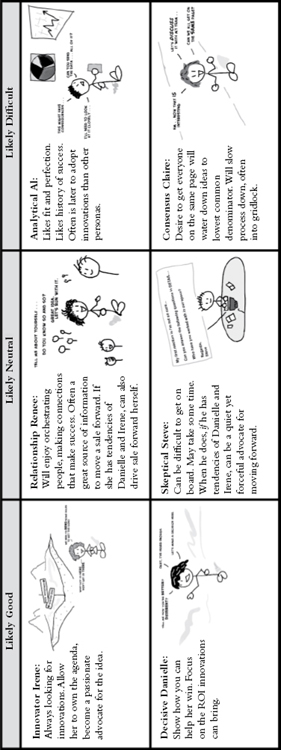
Figure 10.10 Buyer Personas and Insight Selling
Thus, sellers need to learn about the motivations, and preferred interaction and decision styles, of each buyer persona so that they can maximize their effectiveness with each.
We give the six buyer personas names because they have distinct and identifiable personalities. The names will help you remember who’s who.a
1. Decisive Danielle—The Driver
Decisive Danielle likes winning (Figure 10.4). She’s directive and solves problems in a decisive, active, and assertive manner. She is proactive, is results driven, and wants to win. If you’re dealing with Danielle, she might seem pushy and overbearing and may lack tact. She’s probably pretty demanding and wants things to happen her way and in her time frame.

Figure 10.4 Decisive Danielle
If you’re selling to Decisive Danielle, you should be decisive as well and demonstrate willingness to take some risks on your end that can help her succeed. Don’t worry too much about conflict that may arise with Danielle—it doesn’t bother her, and she may even thrive on it. Building consensus is not her natural thing. Not only does she not like the idea of forming a committee, but she also doesn’t like the word.
Also, because Danielle likes winning, she often values speed, knowing that if she doesn’t move first, someone else might. If she’s not bold enough, someone else may be bolder and beat her to the punch.
Implications for Insight Selling
- They’re good buyers for opportunity insight if you can demonstrate return on investment (ROI) and show how you can help them win.
- Be direct and assertive. They don’t mind being told what you think. Tact will rarely hurt you, but know Danielles become frustrated when people beat around the bush.
- Expect them to be direct with you. Don’t get defensive. Rely on your emotional intelligence and don’t get flustered.
- Offer opinions, and be prepared to defend them. Substantiate claims.
- Be clear about what can go wrong (help avoid pitfalls), and be able to give odds on success.
2. Consensus Claire—The Committee Chair
Consensus Claire is the yin to Decisive Danielle’s yang (Figure 10.5). Consensus Claire likes to solve problems with other people. She’s deliberative, tactful, diplomatic, and adaptable. In a world where people can be blunt, it’s likely you’ll find her respectful of you and everyone else.
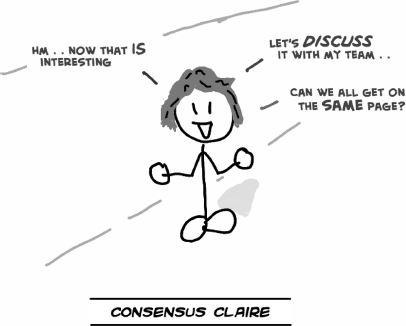
Figure 10.5 Consensus Claire
If you’re selling to Consensus Claire, keep in mind how important getting everyone on the same page will be to her. You’ll have to work with her to understand and include all the various buying influences. Make sure you facilitate discussions to draw out Claire’s and everyone else’s thoughts, needs, and questions. If, for some reason, you decide to pursue a sale with Claire in the buying lead, don’t get frustrated if things take a while. If you need to push back, do it tactfully. If she is going to buy, she will buy when she is ready and her team is all on board. Need to make a big decision? Let’s form a committee!
Also, because Claire values collaboration—which is good because she’ll be open to interacting with you and the team deeply—she is more likely to accept slower action and decision making. Because she may broaden the decision-making group, lots of voices may water down the solution she eventually buys. Thus she is likely to be more accepting of gradual versus radical change (i.e., even if she has influences of Innovator Irene—she’ll want the mountain—her slow decision process may end her up with the molehill).
Implications for Insight Selling
Ever try to get 22 people to agree where to go to dinner? It takes 10 times as long as it should, and you all end up getting pizza or going to a chain restaurant because it’s the only thing people can agree on. The same thing happens with business. A Consensus Claire may love the innovative idea and see the benefit of moving forward, but she’ll become bogged down—and so will you—in the whole process of getting on the same page.
- Innovations can become bogged down in getting everyone to agree. Applying opportunity insight can be difficult.
- Be direct but very tactful. Push too hard and you might turn them off.
- Facilitate discussion, make sure their opinions are drawn out, and give them time to respond.
- Keep the focus on goals, objectives, and expected results.
3. Relationship Renee—The Friend
Relationship Renee is interactive (Figure 10.6). Social interaction and engagement are important to her. She’s enthusiastic, a creative problem solver, a team player, and (of course) a relationship builder. She likes the big picture, and she’s not shy about taking up a lot of airtime in discussions. A question or two will really get her going.
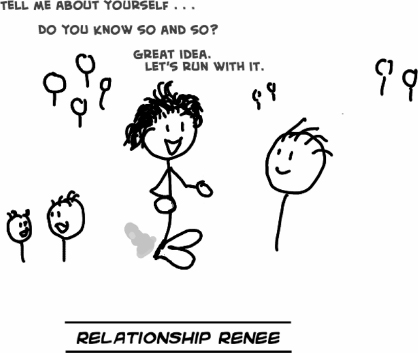
Figure 10.6 Relationship Renee
If you’re selling to Renee, you might want to keep technical details to a minimum. Make sure you hear her ideas, and share (and stoke) her enthusiasm with your own. Renee probably weaves fairly seamlessly between talking about business and personal matters.
You might find the talk about her recent vacation or your son’s basketball team goes on for a bit. When discussing ideas, don’t overdo being the voice of reason or reality. What you might see as realism, she’ll see as a downer.
Implications for Insight Selling
- Relationship Renees are neither good nor bad buyers for insight selling, but they need influences of Decisive Danielle or Innovator Irene to have enough change agent tendencies to move decisions forward.
- Renees often know which buyers to direct you to. They can be great sales champions for you and your interests.
- Share and stoke their enthusiasm. They can be great for socializing new ideas, even if they won’t push them through on their own.
- Make sure their ideas are heard—give airtime.
- Connect them with other people you know that they’d like to know.
- Keep your connection with them current, because they may cheat on your relationship with a competitor if you’re off their radar screen too long.
4. Skeptical Steve—The Guardian
Skeptical Steve is the yin to Relationship Renee’s yang (Figure 10.7). Steve is introspective. He’s a reserved critical thinker. Skeptical Steve won’t embellish and doesn’t want you to do so either. It takes a while for Steve to develop trust with people, which can be great for you if you put in the time and effort. (By the way, Steve doesn’t mind being called a skeptic. He’s proud of the realism he brings to the table.)
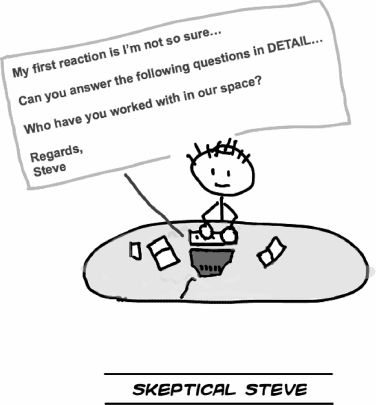
Figure 10.7 Skeptical Steve
If you’re selling to Skeptical Steve, don’t be surprised if he is not super comfortable on the phone and prefers e-mail to communicate. Don’t be unnerved by lack of gestures or feedback; he tends not to be demonstrative one way or the other. Don’t try to be too personal or friendly too fast. Know that Steve might not share much at meetings. But you still need to make sure his needs are met, or he could quietly block your sale. And you might never even know it.
Implications for Insight Selling
Like Relationship Renees, Skeptical Steves are neither good nor bad buyers of new ideas and insights. Like Renees, make sure there are elements of Decisive Danielle or Innovator Irene, or they will be less likely to drive change and push new ideas through resistance.
- It can take a longer time than average to build trust; don’t force it.
- If you aren’t prepared to be subject to rigorous due diligence, focus on other buyers.
- Don’t be overly enthusiastic or demonstrative because they’ll see this as hucksterism.
- If you win them over, they may quietly make a case for moving forward with an idea but still may prefer pilot tests, staged implementations, and risk guarantees or contingencies.
5. Analytical Al—The Spreadsheet
Past success is an indicator of future success (Figure 10.8). The way it’s been done, established methods, and data are important to Analytical Al. This doesn’t mean he won’t lead the pack and do something new; it just takes a lot of processing for Al to take a leap of faith. Al’s cautious. He follows rules, procedures, and established standards. He’s a comprehensive problem solver because he examines from all the different angles.
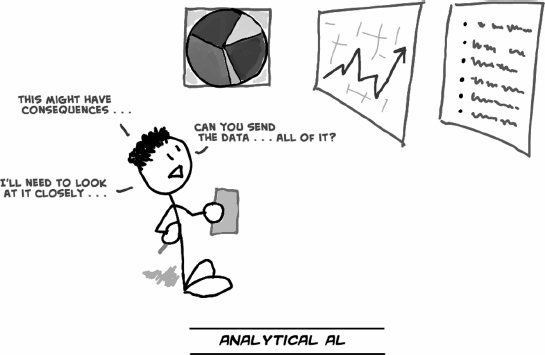
Figure 10.8 Analytical Al
If you’re selling to Analytical Al, provide the backup and data that will help him make a decision. Appropriate detail will be important (and appropriate to him is more than for most people). At some point, because he can sometimes leave the data gate open longer than it needs to be, you might need to push back. Take special care not to criticize because he might take that more personally than others. If you push him too hard to move before he has completed his analysis, you can find yourself and your sale blocked.
Implications for Insight Selling
- Analytical Als aren’t the best buyers for new innovations and change because they value fit and “the way we do things.”
- He will analyze things from many angles; be prepared for scrutiny and requests for more and more information.
- Al likes history of success and supportable data, which aren’t always available in abundance when you’re selling something new; Al will perceive your offering as risky (whereas Danielle or Irene might perceive it as an opportunity, because the competition isn’t doing it yet).
- His need for data can seem insatiable and can take significant time and effort to satisfy.
- Analytical Als’ need for precision sometimes has them looking for perfection versus success, and that can hamper your sale when you’re trying to drive bold, new ideas or even just trying to get something to move forward without figuring out every detail up front.
6. Innovator Irene—The Maverick
Innovator Irene is the yin to Analytical Al’s yang (Figure 10.9). When it comes to rules, procedures, and how things were done before, Irene couldn’t care less. Although Al might say, “Past success is an indicator of future success,” Irene would say, “What got us here won’t get us there.”
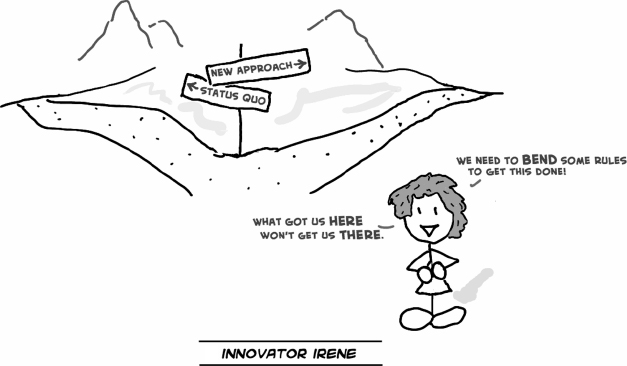
Figure 10.9 Innovator Irene
Innovator Irene develops ideas and strategies independent of rules. She’s informal and solves problems creatively. Boundaries are for testing, pushing, and crossing—that’s what Irene says. (Anyone who has a two-year-old has met this side of Irene.)
Implications for Insight Selling
- By definition, Innovator Irenes are good buyers for new ideas and innovations.
- Brainstorm with them. Stoke ideas for new ways of doing things.
- Allow your agenda for change to become their agenda, and they will advocate for it forcefully.
- Don’t shut down creative talk too early, even if a conversation seems to be veering off target. After a while, move the discussion back on track. Don’t worry too much about seeming disorganized because Irene isn’t.
- Show how working with you can make the ideas become a reality; they won’t want to be too bogged down in implementation.
As you work to identify personas, understand that although there’s usually a dominant persona that bubbles to the top, another often influences and informs the buyer’s buying style and preferences.
In one situation, we were coaching Anne, a seller at a major financial consulting firm, on how to move a sale from almost closed to closed. She found a Decisive Danielle and Skeptical Steve in Jim, an up-and-coming chief operating officer of a billion-dollar division of a global conglomerate.
After a number of frank and direct discussions with Anne about a new way of approaching and managing complex financial transactions, Jim, who was not easy to win over, one day drank the punch of what Anne was selling and wanted to move forward with Anne’s ideas (and services). However, as much as the Danielle persona in him wanted to drive the process forward without any distractions, he had no choice but to include four people on his team in the decision process.
One of those people was Fred—a mix of Analytical Al and Consensus Claire. He was constantly asking for more information. After asking for the information, he would send it back to his team for feedback, and his team would have reams of questions, problems, and issues with moving forward.
The sale had been stalled in the ask-for-more-data-then-share-the-team’s-concerns pattern for about two months. Jim counseled Anne very strongly to work with Fred and win him over; otherwise even if they bought, the implementation would be a disaster. This was a large enough deal for Anne to invest the time and effort to see it through.
After talking to Anne, we learned that she had never had a one-on-one conversation with Fred. We suggested she set one up. In preparation for this meeting, one of the things we suggested she address with Fred was to understand his decision criteria, especially what data he needed to see to make a decision.
We also suggested that Anne let Fred know she was willing to gather, analyze, and prepare information for him but would like to know specifically what it would look like to satisfy what he needed to see. (“I know we’re not there yet, but let’s assume for a minute you say yes. What would you need to see before you would even be willing to do that?”)
After Anne asked, Fred gave her a specific list of questions he needed answers to. She had satisfied most of the list in the previous interactions and was able to then put together a packet of information for her to review with Fred and his team.
The sale closed a month later, with Fred on board to lead the implementation and see it through to success. By being able to identify Fred’s persona as primarily an Analytical Al, Anne was able to move an opportunity insight sale forward and gain an ally in the process.
Chapter Summary
Overview
To succeed with insight selling, your buyers must be inspired to buy when it’s in their best interest. Some are open to being inspired and taking action, and others aren’t. Even if they are willing to take action, some buyers are good buyers for bold ideas and innovations and some aren’t.
Key Takeaways
- To figure out which buyers are good buyers for new ideas and innovations and which aren’t:
- Identify whether the buyers are in the right buying mode to buy anything at all.
- Identify the buyers’ persona—their buying styles and preferences—to get a sense of whether they are likely to be good buyers for new ideas and innovative offerings
- There are two buying modes, problem solving and future seeking, and two nonbuying modes, satisfied and euphoric (happy with the status quo). Your insight selling efforts will see greater success with buyers who are problem solving or future seeking.
- In problem-solving mode, buyers are looking to make improvements in areas that are underperforming. In future-seeking mode, buyers are looking to accelerate growth and achieve greater results.
- Beware of buyers in either of the two nonbuying modes (satisfied or euphoric); you are unlikely to see success selling new ideas and innovative offerings to them.
- When you encounter buyers in problem-solving mode, you should first inquire to uncover afflictions and help solve problems with products and services, and then advocate to show buyers new ideas and possibilities for how to improve.
- When you encounter future-seeking buyers, focus on their aspirations (without excluding their afflictions), and inquire to learn about their visions and agendas. Advocate to give them a sense of what they could achieve, and provide ideas for how to turn their aspirations into reality.
- Learn to identify the six buyer personas, and you can focus your attention on the buyers most likely to buy and adjust your selling approach to the way each buyer persona prefers to buy.
- Decisive Danielle (likely a good buyer for insight selling): Show how you can help her win. Focus on the ROI innovations can bring.
- Innovator Irene (likely a good buyer for insight selling): Always looking for innovations. Allow her to own the agenda and become a passionate advocate for the idea.
- Skeptical Steve (likely a neutral buyer for insight selling): Can be difficult to get on board. May take some time. When he does, if he has tendencies of Danielle and Irene, can be a quiet yet forceful advocate for moving forward.
- Relationship Renee (likely a neutral buyer for insight selling): Will enjoy orchestrating people, making connections that make success. Often a great source of information to move a sale forward. If she has tendencies of Danielle and Irene, can also drive sale forward alone.
- Consensus Claire (likely a difficult buyer for insight selling): Desire to get everyone on the same page will water down ideas to lowest common denominator. Will slow process down, often into gridlock.
- Analytical Al (likely a difficult buyer for insight selling): Likes fit and perfection. Likes history of success. Often is later to adopt innovations than other personas.
- Remember, regardless of the business or emotional reasons that drive people to buy, every buyer has personal preferences for how he or she likes to interact with sellers, make decisions, build strategies, and proceed with action plans. In other words, not everyone buys the same way.
